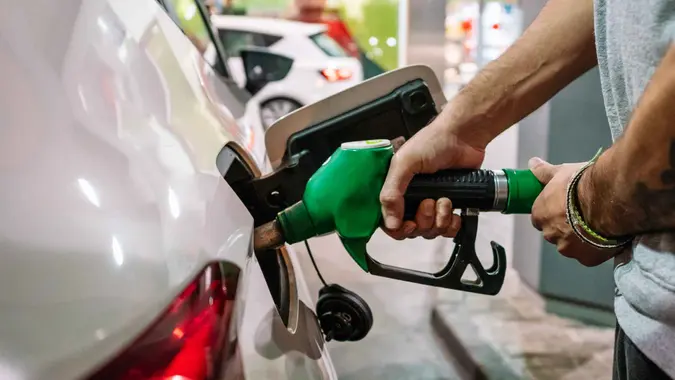4 Key Signs Your Car Isn’t Worth the $738 Monthly Payment

Commitment to Our Readers
GOBankingRates' editorial team is committed to bringing you unbiased reviews and information. We use data-driven methodologies to evaluate financial products and services - our reviews and ratings are not influenced by advertisers. You can read more about our editorial guidelines and our products and services review methodology.

20 Years
Helping You Live Richer

Reviewed
by Experts

Trusted by
Millions of Readers
You might have spent months or years fixating on your dream car without considering the cost of keeping it in your driveway. Now that you have it and the monthly payment that it brings, the wheels might not feel worthy of the dollars you’re spending to live out your automotive dreams.
According to LendingTree, the average monthly new car payment is $738. Do you really have room for that — or anything close to that — in your budget? If you’re asking the question, the answer is probably no.
Look for these signs to decide for sure.
You Owe More Than the Car Is Worth
According to Andy Roberts, founder of Auto Problemz, the clearest sign that your vehicle isn’t worth the monthly payment is if the depreciation rate outpaces the loan repayment. In short, your loan balance is more than the car is worth.
“This situation, also known as the upside-down car loan, means you could end up with negative equity, which can be a significant risk to your financial stability,” he said. “Therefore, I recommend getting the current value of your vehicle determined by a broker or online valuation tools, such as Edmunds. After that, go through your loan structure and calculate how much money you still owe.
“Once you have both values, compare the current value of your car to the remaining balance on your loan. If the market value of your car is less than what you owe, it doesn’t justify the payments anymore.”
Getting Out of an Upside-Down Loan
If your calculations reveal your loan is underwater, worry, but don’t panic.
“There are several options to get out of this situation, such as paying off the loan, refinancing the loan, selling the vehicle, etc.,” said Roberts. “You can also voluntarily surrender the vehicle as a last resort.”
Your Car Payment Is a Monthly Dose of Financial Stress
The second telltale sign doesn’t require calculations or valuations — just an internal financial stress check. Do you dread your payment due date, because you know deep down that you can’t truly afford your car?
“If the total monthly cost of your car, including insurance, maintenance and the payment itself, consistently strains your budget or goes over what you get out of it, that is a clear sign that the monthly payments are not worth it,” said automotive expert Blake Shaw, founder of the All About Wheels blog. “It is important that buying a car does not put too much strain on your finances or cause you serious problems.”
Automotive engineer and consultant William Green concurs.
“If making your monthly car payment means you’re struggling to pay other bills, can’t afford any unexpected expenses or are too cash-strapped to start building savings, that’s a huge waving red flag,” said Green, who worked as a transmission control engineer at Ricardo, a vehicle validation coordinator at McLaren and a control and simulation engineer at Contract Innovation. “A car payment should be something that comfortably fits within your overall budget without putting you under constant financial stress.”
Repair Costs Keep Escalating
Your inability to manage your car loan might have less to do with the loan itself and more to do with the bills the car keeps sending your way between payments.
“Let’s say the payment amount itself is still manageable, but you’re constantly getting walloped by expensive repair bills to keep your car running right,” said Green. “This is another surefire sign it might be time to consider bailing.
“Obviously, all cars will need some routine maintenance and repairs over their lifetime. But if you find yourself basically living at the mechanic’s garage or continually dropping four-figure bills to replace this part or that system, you’ve got to start questioning if these recurring costs are worth it anymore. As a general rule of thumb, if your repair bills are starting to approach or even exceed your car’s current value, selling or trading in is probably the wiser move. An endless money pit is never worth it.”
Your Wheels No Longer Match Your Lifestyle
If you bought a vehicle based on activities you no longer do or needs that have since shifted, your car might no longer be worth the price of the payments.
“Another factor to consider is whether your car is still actually serving your needs and everyday driving habits,” said Green. “Like if you bought a gas-guzzling truck for work or a car for a long highway commute, but then switched to remote work and now only drive short distances around town — or if your family situation has changed and now you need more or less space. If your car is no longer a practical fit for your current lifestyle and driving patterns, even if the payment itself is affordable, it might be worthwhile to recalibrate to a more fitting vehicle.”
In the end, it’s important to remember what a vehicle is supposed to be and the role it’s supposed to play in your financial life.
“A car is a financial tool meant to provide reliable transportation at a reasonable cost,” said Green. “When that tool starts costing you more headache than upside, both financially and practically, it’s time to really assess whether keeping it around any longer is worth the costs.”
 Written by
Written by  Edited by
Edited by 

























